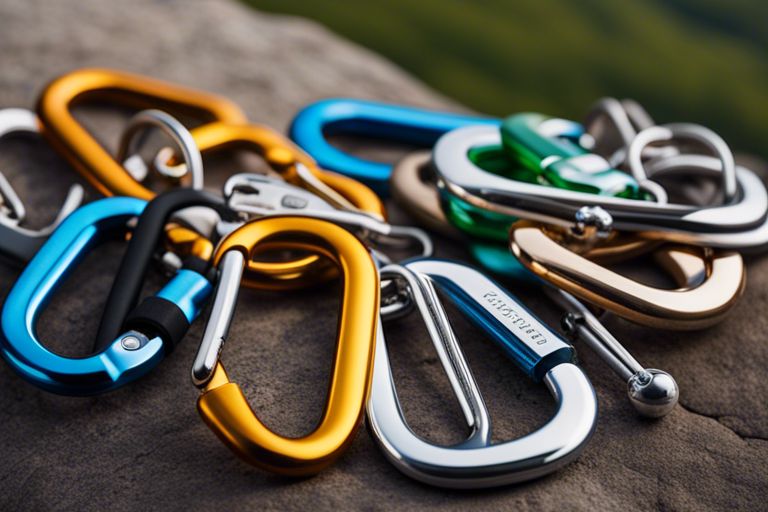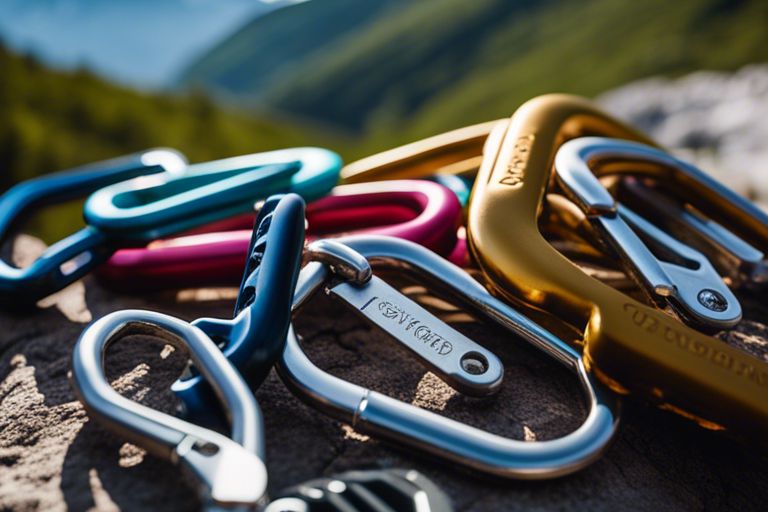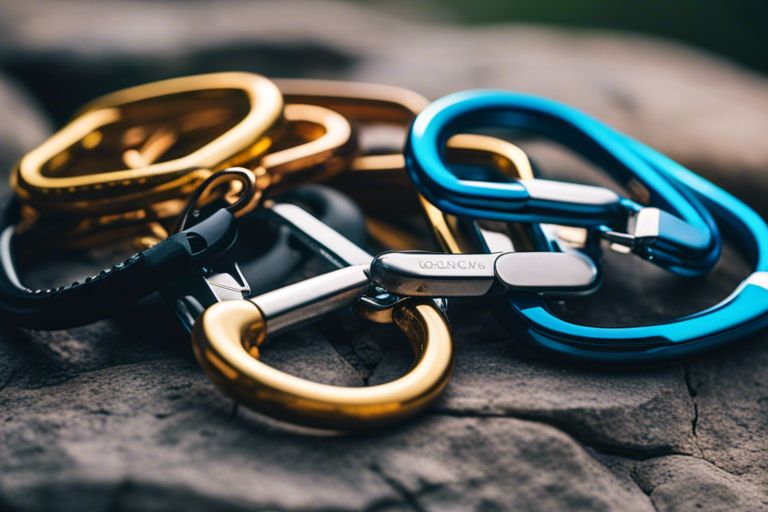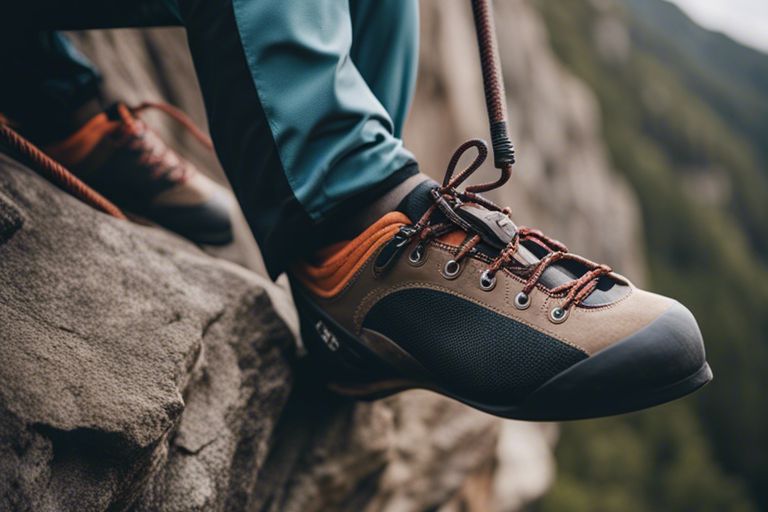Gear. When you head outdoors to climb, knowing how many carabiners you need is imperative. These small, yet mighty pieces of equipment play a critical role in your safety and efficiency. Depending on your climbing style, route, and personal preferences, the number varies. This guide will help you determine how many carabiners you require to tackle your next climbing adventure with confidence.

Key Takeaways:
- Personal Use: The number of carabiners needed can vary based on your climbing style and personal preference; generally, 8 to 12 is a good starting point for most climbers.
- Type of Climbing: Different types of climbing (sport, trad, or mountaineering) may require a different number of carabiners; check your gear requirements for specific activities.
- Safety and Backup: Always consider having extra carabiners for safety and backup systems; an additional 2-4 can be helpful for rigging and emergencies.
Determining Your Carabiner Needs
Before you begin on your climbing journey, understanding how many carabiners you need is crucial for your safety and efficiency. It’s not a matter of simply grabbing as many as you can find. Instead, you must assess your personal climbing style and the specific demands of the climbs you plan to undertake. The right number can vary dramatically from one climber to another, depending on your experience level and the routes you select.
Assessing Your Climbing Style
Style has a significant impact on your carabiner needs. If you prefer sport climbing, you may require fewer carabiners, as fixed protection is often present on the routes. However, if you lean towards trad climbing, where you place your own gear, you’ll need a larger collection to ensure you have what you need for various placements. Your climbing style also influences the types of carabiners you should consider. For instance, if you often climb multi-pitch routes, you might want to carry lightweight, locking carabiners for added security.
Considering the Type of Climbing You’ll Be Doing
Style matters here, too. Each climbing discipline demands different gear considerations. If you are bouldering, a few robust, non-locking carabiners may suffice for quick clips and unclip as you climb. In contrast, alpine climbing often necessitates a wide range of gear, including carabiners for anchors, belaying, and a potential need for rescue scenarios. Be sure to factor in the specific environments and challenges unique to your chosen climbing style.
A wise climber prepares for the variety of situations they may encounter on the rock. For example, if you plan to climb in an icy environment, the conditions may dictate the use of locking carabiners, which are less likely to unclip unintentionally. Knowing the type of climbs you will undertake allows you to build a targeted collection of carabiners, ensuring you are well-equipped and safe as you ascend.

The Basics of Carabiner Usage
While climbing, understanding the function and proper use of carabiners is crucial for your safety. These metal loops with spring-loaded gates connect lashings, harnesses, and ropes. They serve as the backbone of your climbing gear, ensuring that you remain secured to your climbing route. Knowing how to choose and use carabiners is important in creating a reliable climbing system.
What Carabiners Are Used For
Carabiner types vary, but they all share a common purpose. Carabiners are used to attach ropes to anchors, connect different pieces of climbing gear, and create secure links in your climbing system. Different shapes and locking mechanisms serve differing purposes, whether you are sport climbing, trad climbing, or mountaineering. Familiarize yourself with the options to find what suits your climbing style.
How to Properly Attach Carabiners
Carabiner usage goes beyond simple attachment. Carabiners must be placed in a way that maximizes safety and efficiency. When you attach a carabiner to your harness or an anchor, ensure the gate is facing away from the load. This minimizes the chance of accidental openings and keeps the carabiner secure under stress.
What you also need to remember is the importance of inspecting your carabiners before every climb. Any signs of wear or damage signal that a replacement is necessary. Properly secure the carabiner with a smooth, intentional motion, ensuring it locks into place if it has a locking mechanism. This prevents any potential failures while you ascend or descend. Always prioritize safety first when dealing with your climbing gear.
Factors Affecting Carabiner Quantity
Despite the common assumption that a few carabiners will suffice for any climbing adventure, the reality is much more complex. Various factors influence how many you will actually need. Consider these key elements:
- The number of climbers in your party
- The length and complexity of your route
- The type of equipment you’re using
Assume that you are planning a group climb. The number of climbers in your party plays a vital role in determining your carabiner needs. Each climber will typically require several carabiners for personal use, whether for harness attachments or anchoring gear. If you plan to climb as a group, you must also account for carabiners needed for shared protection or setting up anchors.
The Number of Climbers in Your Party
Climbers often overlook the importance of calculating carabiners based on the size of their group. Each climber will demand a personal arsenal for their gear. Beyond personal use, consider any shared gear and collective safety measures. You should think about how many routes you plan to tackle together and whether those routes require additional protection or backup systems.
The Length and Complexity of Your Route
Carabiner choices depend not only on the number of climbers but also on the length and complexity of your route. Longer routes typically call for more anchor points and often involve more gear changes. Quick draws and additional locking carabiners may be necessary to accommodate the changing landscape. Complexity, too, requires careful planning; cliff bands, overhangs, and varied terrain can all add to the number you will need.
Length and complexity make the calculations more intricate. Each piece of gear needs a secure point, and the odd twist in a route may call for unforeseen adjustments. You will want to have enough gear to address any situations heading your way, ensuring safety and efficiency in your climbs.
The Type of Equipment You’re Using
To determine the right number of carabiners, consider the type of equipment you’re using. Different climbing disciplines—be it sport, trad, or alpine—require different gear setups. Sport climbing may require fewer carabiners compared to traditional climbing with protection pieces. Your loadout must accommodate the specific needs of the climbing style you choose.
Quantity can also depend on how many additional devices you plan to carry. A climbing rope needs at least a couple of locking carabiners for belaying, while a rack of quickdraws can further increase your carabiner collection significantly. Therefore, account for this variety to avoid complications on your adventure.
Carabiner Placement and Strategy
Now, understanding how to place your carabiners strategically can make your climbing experience safer and more efficient. Carabiner placement is not just about quantity; it is about knowing where to position them for the best results. This includes factoring in the angles, weight distribution, and the specific climbing route. A well-placed carabiner can help prevent rope drag and ensure quick access when you need to clip or unclipping during your ascent or descent.
Placing Carabiners for Efficient Rappelling
One critical aspect of using carabiners is their positioning during rappel. Proper technique in setting up your rappel system is vital for safety and control. It is necessary to ensure that your carabiners are aligned correctly, as misaligned carabiners can lead to unnecessary friction and potential failure. Always double-check the bend and loading of each carabiner before you take the plunge.
When rappelling, you should use locking carabiners at your anchor points, as they provide an extra layer of security against accidental unclip. Think through the sequence of your rappel, ensuring your carabiners are in a position that allows for smooth movement of the rope through the system. Efficiency here translates to a safer experience as you navigate your descent.
Strategic Carabiner Placement for Anchors
With anchors being crucial points in your climbing route, placing carabiners strategically can enhance your safety and make for a more manageable ascent. You want your carabiners to be easily accessible and to work in unison with your anchor system. Ideally, you should avoid long loops of slack and keep your clips as streamlined as possible to reduce the chances of tangling or getting caught.
The choice of carabiners for your anchor setup matters significantly. Using a mix of locking and non-locking carabiners can provide advantages depending on the situation. For example, while a non-locking carabiner may work well for quickdraws between clips, locking carabiners are preferable for anchors due to their added security. Each carabiner serves a purpose, and knowing how to use them will help achieve a seamless climbing experience.
Using Carabiners for Quickdraws
Efficient use of carabiners in quickdraws is vital when climbing. Quickdraws consist of two carabiners connected by a durable sling, and they serve to bridge the gap between your climbing rope and the protection you’ve placed in the rock. You should always ensure that you are using quickdraws properly, as they are crucial points for securing your ascent and reducing potential rope drag.
To maximize efficiency in your climbing, consider the orientation of the quickdraw carabiners. You should clip the rope through the upper carabiner and ensure that the lower carabiner is oriented correctly to minimize cross-loading. This attention to detail can prevent possible accidents and enhance your climbing efficiency by making each clip feel natural. Always remember that the small things can make a significant difference in your climbing journey.

Common Carabiner Mistakes to Avoid
For climbing enthusiasts, understanding the imperatives of carabiner usage is critical. Here, you will find common mistakes that can compromise your safety. Avoiding these errors ensures a secure and successful climb.
Insufficient Carabiner Quantity
Carabiner count matters. You may underestimate how many you need, but having too few can leave you vulnerable. Each route demands specific gear, and failing to bring the necessary amount can limit your options, especially in tricky situations.
Consider the types of climbs you plan to tackle. A single carabiner won’t suffice for complex routes requiring multiple anchors, quickdraws, or gear placements. Always pack extra; those carabiners could be a lifeline when you least expect it.
Incorrect Carabiner Placement
Carabiner placement is vital for maintaining safety. Every time you clip, ensure the carabiner is positioned correctly. Placing a carabiner at the wrong angle can increase the risk of cross-loading, where loads are misdirected and cause failures during a fall.
Additionally, incorrect placement can lead to accidental unclipping. Always double-check your positioning to promote smooth transitions and prevent mishaps. Recall, each placement counts in the dance between you and the climb.
Incorrect placement can ultimately change the dynamics of your climbing experience. Following best practices prevents unnecessary risks. Pay attention to how you clip and where you clip; your life might depend on it.
Failing to Regularly Inspect Carabiners
Inspect your carabiners routinely. Small signs of wear can escape notice, but wear can weaken their integrity. Before each climb, check for signs of damage, such as scratches, dents, or bent gates. Skipping this step can lead to catastrophic failures.
Climbers often forget that carabiners have a lifespan. Using a damaged or old piece of equipment can jeopardize your safety and that of your partners. Always err on the side of caution and replace any carabiner that seems unfit for use.
Placement concerns arise when you overlook inspection. A worn-out carabiner may not hold up under strain, leading to dangers you could have avoided. Regularly assess your gear for peace of mind on every climb.
Carabiner Maintenance and Inspection
Keep your climbing gear in top condition. Regular maintenance and inspection of your carabiners ensure your safety and performance during climbs. Check for dirt, grime, and other residue after each use. A simple cleaning routine goes a long way.
How to Clean and Store Carabiners
Maintenance is imperative for the longevity of your carabiners. Start by rinsing them with water and mild soap. Avoid harsh chemicals that can damage the metal. Use a soft brush to gently scrub any stubborn spots, especially around the locking mechanism. Rinse again and let them dry completely to prevent rust. For storage, keep your carabiners in a dry, cool place, away from direct sunlight. This will help protect them from moisture and UV exposure, which can weaken the material over time.
Identifying Signs of Wear and Tear
The key to safe climbing is recognizing when your carabiners show signs of wear and tear. Inspect the gate for any bends or misalignments and check the locking mechanism for proper function. Look for scratches, dents, or notable changes in shape. If you notice any of these, it’s imperative to assess whether you should continue using them. Your safety could depend on it.
Keep an eye out for unusual signs, like excessive play in the gate or a rough opening and closing action. Over time, carabiners can succumb to wear through frequent use, leading to structural integrity issues. Be vigilant in your inspections to ensure each climb is as safe as possible.
When to Replace Your Carabiners
Carabiners should be replaced if they exhibit significant signs of damage or wear. Follow the manufacturer’s guidelines for lifespan, taking into consideration the frequency of use and the conditions in which you climb. If you are in doubt about their safety, it’s better to err on the side of caution and invest in new ones.
When you notice cracks, deep scratches, or a weakened gate mechanism, it’s time to say goodbye to your carabiners. The risks involved in climbing demand that you play it safe. Prioritize your gear and replace carabiners that no longer meet safety standards.
To wrap up
Taking this into account, the number of carabiners you need for climbing depends on the type of climbs you undertake and your personal preferences. A good rule of thumb is to have at least six to eight locking carabiners for safety when lead climbing and enough non-locking ones for your quickdraws. Whether you’re climbing crags or tackling multi-pitch routes, being well-equipped will ensure you can focus on the journey ahead without worrying about your gear. Keep in mind, a well-prepared climber is a safer climber.
Ultimately, the goal is to find a balance between being adequately prepared and not overloading your harness. As you gain experience, you’ll discover your own ideal number of carabiners, tailored to your style and the routes you choose. Equip yourself wisely, think ahead, and embrace the spirit of adventure in climbing. Your safety and enjoyment depend on it.
FAQ
Q: How many carabiners do I need for sport climbing?
A: For sport climbing, it’s generally recommended to have at least 8 to 12 quickdraws, which consist of two carabiners each. This means you would need about 16 to 24 carabiners for a sport climbing route, depending on the number of anchors and the climbing style. In addition to quickdraws, you may also want a few locking carabiners for belaying or creating anchors, typically around 3 to 5 locking carabiners for safety. Overall, a good starting point is to have around 20 carabiners in your climbing gear collection to cover any typical day of sport climbing.
Q: Do I need different types of carabiners for different climbing activities?
A: Yes, different types of climbing activities often require different types of carabiners. For instance, if you are doing traditional (trad) climbing, you’ll want a mix of locking and non-locking carabiners for your gear placements and anchor building. For sport climbing, quickdraws with non-locking carabiners are most common, but it’s always good to have locking carabiners on hand for critical connections. If you’re ice climbing, you’ll benefit from specialized locking carabiners designed to handle the specific loads and temperatures involved. Thus, having a variety of carabiners is vital to meet the needs of various climbing styles and safety requirements.
Q: Can I get by with fewer carabiners if I am a beginner climber?
A: As a beginner climber, it is possible to start with fewer carabiners, especially if you’re climbing with more experienced partners who can lend you gear. A minimum of 5 to 10 quickdraws would allow you to join in on sport climbs, while having 2 to 3 locking carabiners would be useful for belaying and creating anchors. However, as you progress in climbing and tackle different types of routes, it’s highly beneficial to invest in a more comprehensive collection of carabiners. This will ensure you have the right gear for safety and versatility as you explore various climbing challenges.




